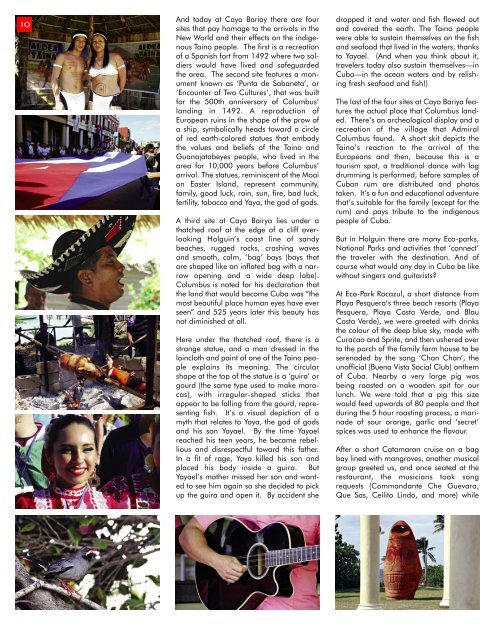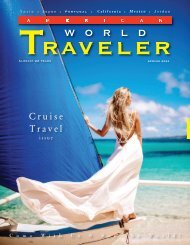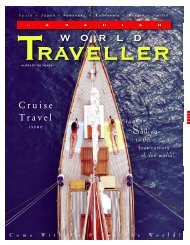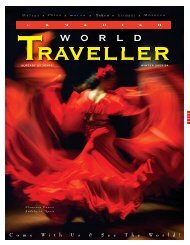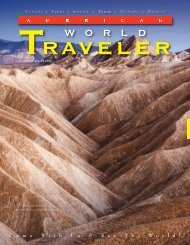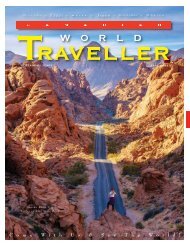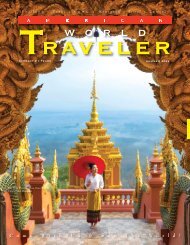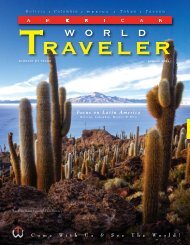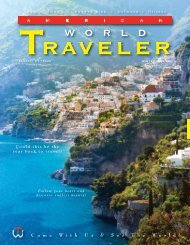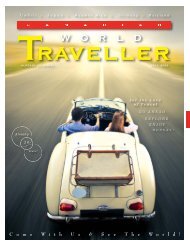American World Traveler Summer 2017 Issue
Now in our 15th year of publishing, American World Traveler explores the culture and history of worldwide destinations, sharing the adventure of discovery with our readers and motivating them to make their travel dreams a reality. Published quarterly, AWT helps sophisticated, independent American travelers choose their next destination by offering a lively blend of intelligent, informative articles and tantalizing photographic images from our World’s best destinations, cruises, accommodations and activities to suit every traveler's taste.
Now in our 15th year of publishing, American World Traveler explores the culture and history of worldwide destinations, sharing the adventure of discovery with our readers and motivating them to make their travel dreams a reality. Published quarterly, AWT helps sophisticated, independent American travelers choose their next destination by offering a lively blend of intelligent, informative articles and tantalizing photographic images from our World’s best destinations, cruises, accommodations and activities to suit every traveler's taste.
Create successful ePaper yourself
Turn your PDF publications into a flip-book with our unique Google optimized e-Paper software.
10<br />
And today at Cayo Bariay there are four<br />
sites that pay homage to the arrivals in the<br />
New <strong>World</strong> and their effects on the indigenous<br />
Taino people. The first is a recreation<br />
of a Spanish fort from 1492 where two soldiers<br />
would have lived and safeguarded<br />
the area. The second site features a monument<br />
known as ‘Punta de Sabaneta’, or<br />
‘Encounter of Two Cultures’, that was built<br />
for the 500th anniversary of Columbus’<br />
landing in 1492. A reproduction of<br />
European ruins in the shape of the prow of<br />
a ship, symbolically heads toward a circle<br />
of red earth-colored statues that embody<br />
the values and beliefs of the Taino and<br />
Guanajatabeyes people, who lived in the<br />
area for 10,000 years before Columbus’<br />
arrival. The statues, reminiscent of the Moai<br />
on Easter Island, represent community,<br />
family, good luck, rain, sun, fire, bad luck,<br />
fertility, tobacco and Yaya, the god of gods.<br />
A third site at Cayo Bairya lies under a<br />
thatched roof at the edge of a cliff overlooking<br />
Holguin’s coast line of sandy<br />
beaches, rugged rocks, crashing waves<br />
and smooth, calm, ‘bag’ bays (bays that<br />
are shaped like an inflated bag with a narrow<br />
opening and a wide deep lobe).<br />
Columbus is noted for his declaration that<br />
the land that would become Cuba was “the<br />
most beautiful place human eyes have ever<br />
seen” and 525 years later this beauty has<br />
not diminished at all.<br />
Here under the thatched roof, there is a<br />
strange statue, and a man dressed in the<br />
loincloth and paint of one of the Taino people<br />
explains its meaning. The circular<br />
shape at the top of the statue is a ‘guira’ or<br />
gourd (the same type used to make maracas),<br />
with irregular-shaped sticks that<br />
appear to be falling from the gourd, representing<br />
fish. It’s a visual depiction of a<br />
myth that relates to Yaya, the god of gods<br />
and his son Yayael. By the time Yayael<br />
reached his teen years, he became rebellious<br />
and disrespectful toward this father.<br />
In a fit of rage, Yaya killed his son and<br />
placed his body inside a guira. But<br />
Yayael’s mother missed her son and wanted<br />
to see him again so she decided to pick<br />
up the guira and open it. By accident she<br />
dropped it and water and fish flowed out<br />
and covered the earth. The Taino people<br />
were able to sustain themselves on the fish<br />
and seafood that lived in the waters, thanks<br />
to Yayael. (And when you think about it,<br />
travelers today also sustain themselves—in<br />
Cuba—in the ocean waters and by relishing<br />
fresh seafood and fish!)<br />
The last of the four sites at Cayo Bariya features<br />
the actual place that Columbus landed.<br />
There’s an archeological display and a<br />
recreation of the village that Admiral<br />
Columbus found. A short skit depicts the<br />
Taino’s reaction to the arrival of the<br />
Europeans and then, because this is a<br />
tourism spot, a traditional dance with log<br />
drumming is performed, before samples of<br />
Cuban rum are distributed and photos<br />
taken. It’s a fun and educational adventure<br />
that’s suitable for the family (except for the<br />
rum) and pays tribute to the indigenous<br />
people of Cuba.<br />
But in Holguin there are many Eco-parks,<br />
National Parks and activities that ‘connect’<br />
the traveler with the destination. And of<br />
course what would any day in Cuba be like<br />
without singers and guitarists?<br />
At Eco-Park Rocazul, a short distance from<br />
Playa Pesquera’s three beach resorts (Playa<br />
Pesquera, Playa Costa Verde, and Blau<br />
Costa Verde), we were greeted with drinks<br />
the colour of the deep blue sky, made with<br />
Curacao and Sprite, and then ushered over<br />
to the porch of the family farm house to be<br />
serenaded by the song ‘Chan Chan’, the<br />
unofficial (Buena Vista Social Club) anthem<br />
of Cuba. Nearby a very large pig was<br />
being roasted on a wooden spit for our<br />
lunch. We were told that a pig this size<br />
would feed upwards of 80 people and that<br />
during the 5 hour roasting process, a marinade<br />
of sour orange, garlic and ‘secret’<br />
spices was used to enhance the flavour.<br />
After a short Catamaran cruise on a bag<br />
bay lined with mangroves, another musical<br />
group greeted us, and once seated at the<br />
restaurant, the musicians took song<br />
requests (Commandante Che Guevara,<br />
Que Sas, Ceilito Lindo, and more) while


